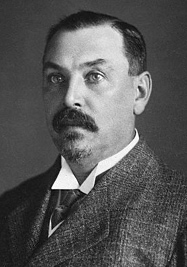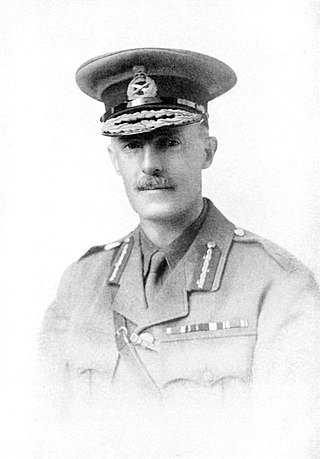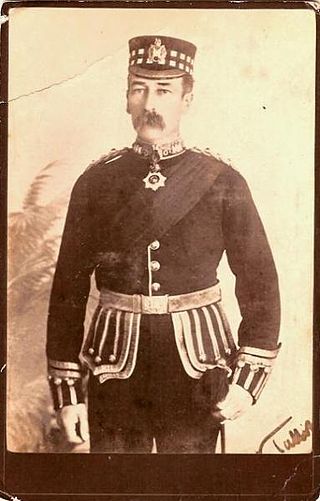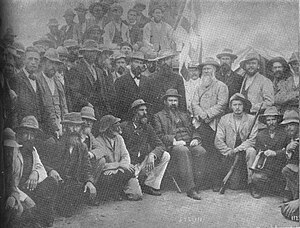
The Second Boer War, also known as the Boer War, the Anglo–Boer War, or the South African War, was a conflict fought between the British Empire and the two Boer Republics over the Empire's influence in Southern Africa from 1899 to 1902.

Louis Botha was a South African politician who was the first prime minister of the Union of South Africa – the forerunner of the modern South African state. A Boer war hero during the Second Boer War, he eventually fought to have South Africa become a British Dominion.

The Battle of Spioen Kop was a military engagement between British forces and two Boer Republics, the South African Republic and the Orange Free State, during the campaign by the British to relieve the besieged city Ladysmith during the initial months of the Second Boer War. The battle was fought 23–24 January 1900 on the hilltop of Spioen Kop(1), about 38 km (24 mi) west-southwest of Ladysmith and resulted in a Boer victory.

General Sir Redvers Henry Buller, was a British Army officer and a recipient of the Victoria Cross, the highest award for gallantry in the face of the enemy that can be awarded to British and Commonwealth forces. He served as Commander-in-Chief of British Forces in South Africa during the early months of the Second Boer War and subsequently commanded the army in Natal until his return to England in November 1900.

The siege of Ladysmith was a protracted engagement in the Second Boer War, taking place between 2 November 1899 and 28 February 1900 at Ladysmith, Natal.

The Battle of Colenso was the third and final battle fought during the Black Week of the Second Boer War. It was fought between British and Boer forces from the independent South African Republic and Orange Free State in and around Colenso, Natal, South Africa on 15 December 1899.

The Battle of Berg-en-dal took place in South Africa during the Second Anglo-Boer War.
The 10th Infantry Brigade was a Regular Army infantry brigade of the British Army formed during the Second Boer War in 5th Division, and during both World Wars the brigade was part of the 4th Infantry Division.

Major General George Tupper Campbell Carter-Campbell, was a senior British Army officer who served in the Second Boer War and the First World War.

When the Second Boer War broke out on 11 October 1899, the Boers had a numeric superiority within Southern Africa. They quickly invaded the British territory and laid siege to Ladysmith, Kimberley and Mafeking. Britain meanwhile transported thousands of troops both from the United Kingdom itself and from elsewhere in the Empire and by the time the siege of Ladysmith had been lifted, had a huge numeric superiority.
The Battle of Ladysmith was one of the early engagements of the Second Boer War. A large British force which had concentrated at the garrison town of Ladysmith launched a sortie on 30 October 1899, against Boer armies which were slowly surrounding the town. The result was a disaster for the British. The main body was driven back into the town, and an isolated detachment of 800 men was forced to surrender to Commandant De Wet. The Boers did not follow up their advantage by proceeding towards the strategically important port of Durban, and instead began a siege of Ladysmith, which was relieved after 118 days. John Norwood was awarded the Victoria Cross for his actions during the battle.

The Battle of Tugela Heights, consisted of a series of military actions lasting from 14 February through to 27 February 1900 in which General Sir Redvers Buller's British army forced Louis Botha's Boer army to lift the Siege of Ladysmith during the Second Boer War.
Lieutenant-General Sir Richard Harte Keatinge Butler was a British Army general during the First World War. He was Chief of Staff to First Army for much of 1915, then Deputy Chief of Staff to the BEF from the end of 1915 to the start of 1918. For much of 1918 he commanded III Corps in the front line.
Sir William Fry, was a British Army officer who served in the Second Boer War and the First world war, and later became Lieutenant Governor of the Isle of Man.
Major General Sir Geoffrey Barton, of the 7th Regiment of Foot, served the British Army from 1862 until 1904. Although he saw service in Ireland, Hong Kong and India, the majority of his campaigns were on the African continent. During the Second Boer War he was put in command of the 6th Brigade of the South Natal Field Force, taking part in the Relief of Ladysmith and the Relief of Mafeking. When he retired to Scotland he took an interest in local politics, the Red Cross Society and the Boy Scout Movement.

Major-General John Talbot Coke (1841–1912) of Trusley in South Derbyshire was a British Army officer who served in the 25th Foot between 1859 and 1901. He wrote a family history book called "Coke of Trusley, in the County of Derby, and Branches Therefrom; a Family History" which was published in 1880. He was a Brigade Commander during the Second Boer War having a prominent role in the battles of Spion Kop and the Tugela Heights during the relief of Ladysmith.
The Natal Field Force (NFF) was a multi-battalion field force originally formed by Major-General Sir George Pomeroy Colley in Natal for the First Boer War. It was later re-established for the Second Boer War (1899–1902) and commanded by Major-General Sir Redvers Buller VC GCB GCMG.
The South African Light Horse regiment of the British Army were raised in Cape Colony in 1899 and disbanded in 1907.

The Battle of Boshof was a battle fought during the Second Boer War on 5 April 1900 between British forces and mostly French volunteers of the Boer army.
Major-General George Hanbury Noble Jackson was a British Army officer.
This page is based on this
Wikipedia article Text is available under the
CC BY-SA 4.0 license; additional terms may apply.
Images, videos and audio are available under their respective licenses.














